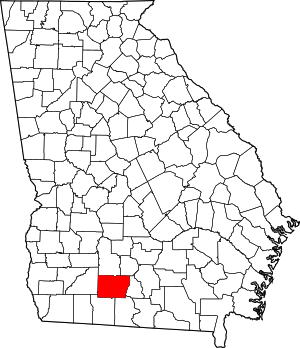
Fast, affordable Internet access for all.

Windstream Communications and local nonprofit electrical cooperative Colquitt Electric Membership Corp are partnering on a $32.5 million fiber deployment that will bring fiber optic broadband to 17,000 homes and businesses in Colquitt County, Georgia.
Once completed sometime next year, the partnership should help deliver last-mile fiber access to roughly 70% of Colquitt County residents, many of which either have no current broadband access, or have long been stuck on sluggish, expensive, and dated digital subscriber line (DSL).
Windstream will maintain ownership of the finished network and provide residential service under its Kinetic brand, while Colquitt EMC will utilize the network to help maintain and support the company’s existing electrical grid.
Kinetic will use $21.4 million in American Rescue Plan Act (ARPA) grants to fund the network build, while providing $11.1 million of its own funds to cover any cost overruns. The company says it has already laid 180 miles of cable of an expected 440 miles total county wide.

“Colquitt EMC has been an instrumental part in the delivery of fiber in its service area,” Kinetic Georgia operations President Michael Foor said in a prepared statement. “We are grateful for its willingness to support these efforts.”
As ILSR has long noted, PPPs can be a decidedly mixed bag. They can be good for municipalities unable or unwilling to handle the logistics or cost of a major deployment alone. At the same time, locals don’t have much or any control over the trajectory of the finished network, including pricing that can quickly creep out of the range of affordability.
Suwannee Valley Electric Cooperative (SVEC) has begun construction on an ambitious new fiber deployment that will soon bring affordable, multi-gigabit fiber access to all of the cooperative’s existing electrical customers in rural Northern Florida.
Cooperative officials tell ILSR its three-phase build out is well underway, with a beta anticipated this summer and the first commercial customers connected by August. SVEC Communications Director Jon Little says the cooperative’s goal remains to deliver affordable fiber to all 20,000 of the cooperative's current electric customers by the end of 2026.
“We’ve broken our territory into three phases based partly on population or possible customers,” Little said.
The cooperative’s recently created subsidiary, Rapid Fiber Internet, will interface directly with subscribers, while Conexon manages deployment of more than 4,100 miles of fiber. Electrical users won’t see price hikes; the projected $93 million deployment cost will be funded by a combination of grants and loans paid back exclusively through user subscriptions.

Little told ISLR that make ready (preparing utility poles for fiber attachments) prep and engineering for phase one are complete, and make ready construction for phase one is roughly 40 percent complete. He added that primary fiber construction for phase one is roughly twenty percent complete.
“We’re hoping that we will have a group of beta customers starting next month,” Little said. “We want to go about a month to get their feedback, and so we’re still hoping sometime in August to offer hookups to our members on that first feeder.”

Bill Callahan, Executive Director of Connect Your Community, joins Christopher Mitchell to talk about some of the history of digital equity and the before-times that led to the formation of the National Digital Inclusion Alliance. We also discuss Cleveland and later NE Ohio more specifically after exploring how Internet access has changed in the area since their landmark report, "AT&T’s digital redlining of Cleveland."
This show is 19 minutes long and can be played on this page or using the podcast app of your choice with this feed.
Transcript below.
We want your feedback and suggestions for the show-please e-mail us or leave a comment below.
Listen to other episodes here or see other podcasts from the Institute for Local Self-Reliance here.
Thanks to Joseph McDade for the music. The song is On the Verge and is used per his Free-Use terms.
Kicking off the new year, Georgia Gov. Brian Kemp’s office announced $234 million of the state’s Capital Projects Fund (CPF) will be used to deploy new high-speed Internet infrastructure in the Peach State, courtesy of the American Rescue Plan Act.
The lion’s share of those federal funds, being administered by the state’s broadband office, will be gobbled up by the four national telecom giants operating in the state. The rest of the grant money will be shared by a half dozen electric cooperatives for smaller projects.
In total, the grants were awarded to 12 different applicants to fund 29 different projects across 28 counties.
“When combined with significant capital matches from the awardees, almost $455 million will be invested to serve over 76,000 locations in communities with some of the greatest need for high-speed Internet access,” the Governor’s office said in the Jan. 4 press announcement.
The Big Telecom winners were Comcast, netting almost $67 million for eight projects that looks to extend broadband access to nearly 28,000 locations; $39.3 million for five Spectrum projects that plan to pass nearly 19,000 locations; Windstream raking in $34.8 million for four projects to make high-speed Internet service available to 4,500 locations, and MediaCom hauling in $27.9 million for three projects to reach 8,200 addresses.
The electric cooperative grant awards were:
While known for its annual "Tulip Time" celebration, Pella is now celebrating the flowering of a municipal fiber-to-the-home (FTTH) network in this small central Iowa city.
Network planners say construction, deploying 100 percent of the fiber underground, is on track to be finished this week. And, although the city has not launched a formal marketing campaign, they have already reached a take-rate of over 40 percent with one subscriber now getting 10 gig service.
The new network is known as Pella Fiber – a subsidiary of the city’s municipal electric utility, which, in the words of the Pella Chronicle, has been bringing “rays of light … (to) dispel the darkness” for residents and businesses in this community since 1911. Over a hundred years later, and with 92 percent approval at the ballot box, Pella voters in May of 2018 authorized the creation of a new municipal telecommunications utility that would transmit rays of light through fiber optic cables. The vote would lay the groundwork for future-proof connectivity in this city of about 10,000 residents, just 44 miles east of Des Moines.
It took two years to develop the business plan and design the network before the city hired Excel Utility Contractors to begin construction in June 2020. First having deployed nearly 34 miles of fiber, network builders connected Pella’s backbone to the Grinnell Hospital facilities nearby, a collaboration that linked the two cities, a critical part of the core network that allowed Pella to provide the needed bandwidth to build out to Pella residents and businesses.
Jamestown - home to 30,000 residents, the largest population center in western Chautauqua County - could become the first city in the state of New York to construct a citywide municipal fiber network using American Rescue Plan relief funds.
In April, Mayor Eddie Sundquist formed a task force to assess the potential for a municipal fiber network in Jamestown. The city is currently working with EntryPoint Networks on a feasibility study to estimate the overall cost of the project, as well as surveying residential interest in building a municipally owned open access broadband network in Jamestown.
If the city's American Rescue Plan spending plan is approved by the Jamestown City Council, Jamestown will be the first city in New York state to embark on a municipal fiber build. Although many cities across New York state own dark fiber assets, and cooperatives in the southeastern and northern regions of the state are serving some residents, no city in the Empire State has moved forward with building a citywide fiber-to-the-home (FTTH) network.
Idea Dating Back to Sundquist’s Mayoral Campaign
Connecting citizens to new technology was a component of Mayor Eddie Sundquist’s 2019 mayoral campaign, centered around efforts to enhance economic development and community revitalization projects.
“Who says that we can’t become a technology hub attracting businesses around the country with our low cost of living and rich resources? Who says we can’t wire broadband and fiber to every home and business in this city at a lower cost?,” WRFA reported Sundquist campaigning in 2019.
In an interview with ILSR, Mayor Sundquist recalled that the message was well-received by Jamestown residents, and that even pre-pandemic, city residents were calling for more reliable Internet access offering higher speeds.
Fed up with poor speeds and no service, a handful of residents in Washington County, Ohio have teamed up to form a broadband cooperative to pursue better connectivity for themselves and their neighbors.
The Southeast Ohio Broadband Cooperative (SEOBC), created last May, is the result of work led by David Brown. “Electric cooperatives worked,” he said of the founding impulse. “Why can’t we do the same thing for broadband?”
After organizing, the first step the group took was to set up a speed test and map to both show how poorly connected many residents of Washington County are, and to plan for the future. That test is still ongoing, and the results are not terribly encouraging so far. Out of 4,662 run, almost 800 premises have no service (17%). Suddenlink and Charter are the only providers returning averages above the FCC’s threshold for basic broadband (25/3 Mbps (Megabits per second)), but together they represent just over 10% of those taking tests — though admittedly this is the result of sample bias, the map shows that outside of Marietta, Lovell, Beverly, Vincent, and the few other concentrated areas there are few providers returning adequate speeds. Subscribers to Frontier, Windstream, and ViaSat across the county see average connections of around 8/2 Mbps (Megabits per second). Those on HughesNet even worse off, at 3/2.5 Mbps.
Asa Boring, a Belpre Township trustee, told the Marietta Times:
We have people in our area who have sort of Internet, but it’s kind of a hit and miss thing. But when you get a mile out of Little Hocking it’s over with, you just don’t get it . . . unless you sign up with Windstream and sometimes it works and sometimes it doesn’t.
Targeted Solutions
Over the summer, Windstream and Colquitt Electric Membership Corporation announced that the two entities will work together to expand fiber optic Internet access throughout the electric co-op’s service territory in rural south Georgia. Windstream, the fifth largest telephone company in the nation, will maintain ownership of the newly deployed network and use it to offer its Kinetic broadband services to residents and businesses, while Colquitt, which has more than 45,000 members, will take advantage of the fiber connectivity to improve the management of its electric grid.
The announcement came one year after Georgia lawmakers clarified that electric cooperatives in the state are able to invest in broadband infrastructure to serve their members and established guidelines for co-ops that want to get into the business.
Working Out the Details
According to Telecompetitor, the project will expand Fiber-to-the-Home connectivity and gigabit speeds to Colquitt members who currently have access to Windstream’s much slower DSL services.

Windstream plans to use Colquitt’s labor force and its Rights-of-Way and electric poles to help deploy the network, but the telephone company will own the actual fiber optic lines. Colquitt will receive an indefeasible right of use (IRU) for some of the fiber capacity for internal uses and smart grid applications.
Grinnell, Iowa, home to about 9,000 people, has a need for speed. That’s why the city is looking to Mahaska Communication Group (MCG) to provide high-speed Internet service of up to 1 Gbps (1,000 Mbps) over a Fiber-to-the-Home (FTTH) network. After MCG announced the possibility in mid-April 2019, Windstream Communications now also plans to bring FTTH to Grinnell according to The Scarlet and Black.
“Undeniable Correlation"
MCG has already distributed a two-question survey to residents in the Grinnell area to determine interest in the FTTH network. To give residents an estimate of the prices, MCG linked the price list for Oskaloosa. The prices are $50 for 25 Mbps (download) / 25 Mbps (upload) and $75 for 1 Gbps/1 Gbps. The company also offers triple play packages of Internet, TV, and phone.
The Grinnell Area Chamber of Commerce stated that MCG may start building the FTTH network in 2020. Similarly, Windstream has revealed a plan to start building its own FTTH network in Grinnell in the Fall of 2019. City Manager Russ Behrens told The Scarlett and Black:
"At the end of the day, our goal is not necessarily to support one [Internet service provider] over the other, it’s to provide the best broadband service to the community that we can, so that’s what we’re trying to do.”
He also mentioned that there was “an undeniable correlation" between the MCG interest and the Windstream announcement.
Two Years of Examination
Georgia has a few areas where businesses and residents can obtain high-quality Internet access, usually from munis, but most of the rural areas of the state are still lacking when it comes to connectivity. In order to find out exactly how big the problem is, state lawmakers are asking rural Georgia residents to complete an online broadband survey.
Asking Rural Residents
State Sen. Steve Gooch told the Gainesville Times, the results will be used by a joint committee of lawmakers who will then make recommendations to the General Assembly next year. “One of the biggest problems I have gotten complaints about from my constituents is the Internet,” he said.
Incumbent Windstream has promised to upgrade in areas of the state, but U.S. Representative Doug Collins from northeast Georgia has fielded calls from constituents that leave him wondering if they will ever live up to those promises:
“It is my hope that this survey truly demonstrates what the broadband experience is like for users in Northeast Georgia. It is one thing to hear promises from the internet service providers, but the truth will lie in the responses of real consumers,” Collins said in a statement to The Times.
“I welcome the state to the fight for rural broadband and look forward to working with them as I continue the effort on behalf of my constituents to get the best service possible. Reliable broadband is critical to growing our economic footprint and the day-to-day functioning of our citizens.”
Take The Survey!
If you are a Georgia resident living in a rural area, take a few moments to fill out the survey here, to let lawmakers know how difficult it is for you to obtain good connectivity. Unless they know the scope of the problem, they will never take steps to fix it.